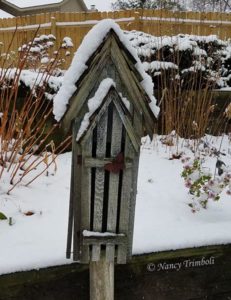Butterfly boxes, also known as butterfly hibernation boxes or butterfly houses, are long, skinny boxes with thin slits usually on the front. The intent of the butterfly box is to give butterflies a dry place to go during inclement weather or a place to hibernate during the winter. (In the eastern U.S., we have a few species that overwinter as adult butterflies.) A simple internet search will bring up a long list of places to purchase butterfly boxes or plans for building one.

Unfortunately, butterflies don’t seem to use the butterfly boxes. Everything I’ve ever read or heard about them indicates zero evidence that butterflies actually use the boxes. However, many people enjoy putting butterfly boxes out as garden decorations, even if they never see a butterfly using it. In general, the thought has always been, “They aren’t doing any harm, so why not?” But new research from the University of Kentucky suggests that having butterfly boxes in your pollinator garden may not be as benign as we once thought.
As part of his dissertation, Adam Baker from the University of Kentucky (UK) looked at monarch caterpillar predation in pollinator gardens on UK’s campus. He found that European paper wasps were a common predator of young monarch caterpillars. European paper wasps are an introduced species of wasp that is most common near human dwellings, making urban and suburban areas perfect habitat for it.
Baker also surveyed the butterfly boxes that were located in or near the pollinator gardens. Almost every butterfly box that he looked at had a European paper wasp nest in it. This suggests that the butterfly boxes could actually be having negative impacts on the local butterfly populations by creating habitat for an introduced predator of the caterpillars.
Based on this new research, if your goal is to provide butterfly habitat with your gardens then you might be better off skipping the butterfly boxes. There’s no evidence that they help butterflies in any way. Instead, they may be helping artificially inflate predator populations that could impact caterpillar numbers and survival. Or, if you want to keep your cute garden decoration, try closing up the slits (maybe with a board or something on the inside) so that wasps can’t get inside. I’m all about allowing predators in the garden and creating a functioning ecosystem, but it’s also about balance and that might not include providing additional habitat for a non-native predator.

Backyard Ecology: Exploring Nature in Your Backyard
Nature isn’t just “out there.” It’s all around us, including right outside our doors. Hi, my name is Shannon Trimboli, and I am the host of Backyard Ecology. I live in southcentral Kentucky and am a wildlife biologist, educator, author, beekeeper, and owner of a nursery specializing in plants for pollinators and wildlife conservation. I invite you to join me as we ignite our curiosity and natural wonder, explore our yards and communities, and improve our local pollinator and wildlife habitat. Learn more or subscribe to my email list at www.backyardecology.net.

Leave a Reply